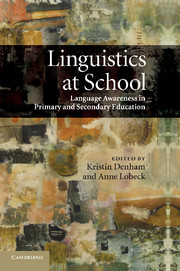Book contents
- Frontmatter
- Contents
- Notes on contributors
- Foreword: The challenge for education
- Introduction
- Part I Linguistics from the top down: encouraging institutional change
- Part II Linguistics from the bottom up: encouraging classroom change
- Part III Vignettes: voices from the classroom
- Introduction to Part III
- 16 And you can all say haboo: enriching the standard language arts curriculum with linguistic analysis
- 17 Code switching: connecting written and spoken language patterns
- 18 A primary teacher's linguistic journey
- 19 Why do VCE English Language?
- 20 Language lessons in an American middle school
- 21 The diary of Opal Whiteley: a literary and linguistic mystery
- 22 Using the Voices of North Carolina curriculum
- 23 A-level English Language teaching in London
- References
- Index
Introduction to Part III
Published online by Cambridge University Press: 04 August 2010
- Frontmatter
- Contents
- Notes on contributors
- Foreword: The challenge for education
- Introduction
- Part I Linguistics from the top down: encouraging institutional change
- Part II Linguistics from the bottom up: encouraging classroom change
- Part III Vignettes: voices from the classroom
- Introduction to Part III
- 16 And you can all say haboo: enriching the standard language arts curriculum with linguistic analysis
- 17 Code switching: connecting written and spoken language patterns
- 18 A primary teacher's linguistic journey
- 19 Why do VCE English Language?
- 20 Language lessons in an American middle school
- 21 The diary of Opal Whiteley: a literary and linguistic mystery
- 22 Using the Voices of North Carolina curriculum
- 23 A-level English Language teaching in London
- References
- Index
Summary
In Parts I–II we have seen that in order for linguistics to be integrated into the K-12 curriculum, it must “fit” in some way with teachers' pedagogical goals and needs. This notion of “fit” can be narrow (specific lesson plans and strategies designed to improve reading and writing test scores) or broad (in the form of lessons and activities that improve students' critical thinking skills and knowledge of language). The choice of one approach over another depends on a number of different factors: resources available, curricular flexibility, testing and assessment pressures, administrative support, etc. One theme that emerges in Part III is that making room for linguistics in the curriculum does not require jettisoning something else; teachers need and embrace effective ways to teach about language, in particular given the ineffectiveness of traditional approaches. Indeed, as we've seen throughout this volume, the failure of traditional grammar teaching (if grammar is taught at all) has created a niche for a different, more effective approach to teaching about language.
This section contains contributions from K-12 teachers themselves, and is perhaps the most important part of this book. Here we see first hand the creative and inspiring ways that teachers have changed their teaching about language, and how these changes have affected not only student learning, but teachers' own attitudes and knowledge of language as well.
- Type
- Chapter
- Information
- Linguistics at SchoolLanguage Awareness in Primary and Secondary Education, pp. 229 - 233Publisher: Cambridge University PressPrint publication year: 2010



